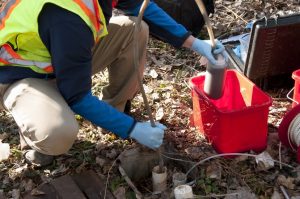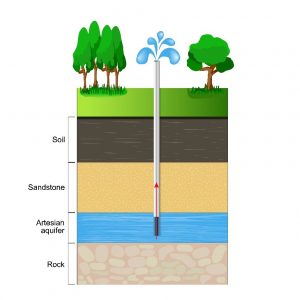REGENESIS is an expert in remediation and this topic will guide you through how groundwater is remediated.
To begin, groundwater remediation is the process that treats polluted groundwater by removing the pollutants and/or converting them into harmless products. Groundwater is essentially water present below the ground surface, often in underground layers of water-bearing permeable rock, rock fractures, or unconsolidated materials known as aquifers. The goal of remediation is to make groundwater safe for humans and minimize the negative impact contaminants have on the environment. Additionally, soil or sediment can also be remediated if it’s contaminated as a result of coming in contact with contaminated groundwater.
There are two types of groundwater remediation: in situ (in place or on-site) and ex situ (off-site). The in-situ remediation approach involves cleaning the water where it is presently situated, rather than removing and transferring it elsewhere. This is a less expensive alternative to removing and treating it away from the property. Ex-situ remediation involves having the contaminated water excavated and then eliminated off-site. The advantage to this approach is that it’s impossible for any further damage to be done at the current location, but it extends the process and is more expensive. Ex situ remediation is sometimes more beneficial when subsurface contaminant levels exceed those which can be treated via in situ remediation. Overall, both types get the job done and every project should be taken case by case. REGENESIS technologies focuses on in situ solutions and some examples of successful remediation projects are highlighted here in our project profiles.
The actual remediation of a site, or restoring the soil and groundwater to a usable state, can be achieved utilizing many different methods. Techniques include biological, chemical, and physical treatment technologies. The traditional approach is “pump and treat” which is physically pumping out the contaminated groundwater using a vacuum pump and then purifying the groundwater using materials that absorb the contaminants. In 1994, REGENESIS introduced a revolutionary approach to treating groundwater that offered an alternative to pump and treat. Oxygen Release Compound (ORC) was the first of its kind and quickly became the standard for leading environmental consultant firms to treat a number of sites with groundwater contaminants including benzene, DCE, MTBE, and vinyl chloride. With the advent of chemical in situ groundwater technologies and approaches, environmental consulting firms no longer had just one choice.
Today, backed by scientific research and testing, REGENESIS provides a host of technology-based solutions including but not limited to: in situ sorption and biodegradation, in situ chemical oxidation (ISCO), enhanced aerobic or anaerobic biodegradation, bioaugmentation, and more. The type of site, whether it’s an industrial site or a brownfield, will determine which solution will perform best. Our technological solutions at REGENESIS are state-of-the-art incorporating the appropriate combination of expertise, products, and application methods.
Remediation often requires many different tests and phases of cleaning to restore groundwaterentirely. After each phase, the groundwater must be sampled and tested to see if it meets certain criteria determined by the state, federal, and local government. Ideally, if it meets or exceeds the regulatory standards following the monitoring period, the project is considered complete and contaminant levels are said to be at non-detect. If the data comes back above the required standards, more rounds of testing may occur. It’s not uncommon for projects to take years to complete. In some cases, the property owner may introduce a different approach and strategy for treatment of their site. REGENESIS has worked with many consultants who have been engaged to take over long-lasting projects by providing proven effective technologies and services to the affected site with great success where other approaches may have failed.
Overall, groundwater remediation is an important aspect in protecting the environment and we are proud to do our part by providing a variety of treatment approaches addressing contaminated sites. If you’d like a more in-depth and scientific look at the different types of technologies used to treat contaminated groundwater, check out Remediation Solutions on our site.


 Americas
Americas Europe
Europe Français
Français Deutsch
Deutsch Italiano
Italiano Español
Español




